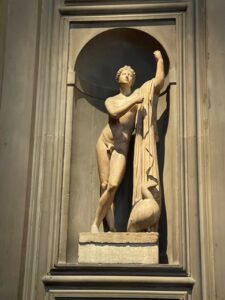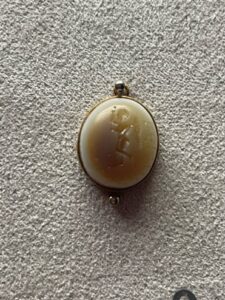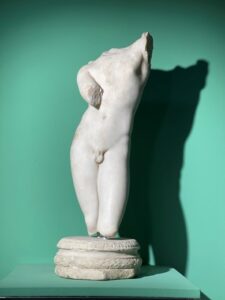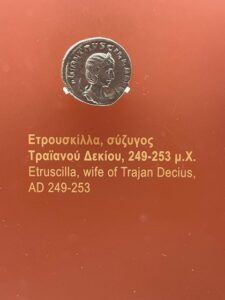Pothos: Longing from Classical Portrait Image to Byzantine Icon
Rachel Catherine Patt
Thanks to the generous support of the Shohet Scholars grant program over the academic year 2022—2023, I was able to make crucial progress on my research output related to the topic of pothos, or longing for an absent loved one, and image-making practices in the premodern Mediterranean. Over the course of the year, I advanced my book manuscript, completed and submitted two accompanying article manuscripts, made headway on a shorter third article, and presented my research to various audiences.
The past academic year gave me the time and space to think in a serious and sustained fashion about the monograph stemming from my dissertation, “Meaning, Materiality, and Pothos in Late Antique Gold-Glass Portraiture.” By having the opportunity to meet with scholars and gain feedback on the project, I have now restructured it into six body chapters, each anchored in a single portrait from the ancient world and early Byzantium, to give its argumentative arc an objects-rooted focus. I have prepared a draft of the book proposal in addition to work on individual chapters, and will submit it to leading academic presses by the end of this calendar year. In its final formulation, I have revised the title of the book to Intimate Encounters: Memory, Pothos, and Portraiture in the Premodern Mediterranean.
The Shohet Scholars grant enabled extensive travel to see collections of Roman portraits and Byzantine icons that were instrumental in shaping the final scope of my monograph. The grant underwrote stays in Copenhagen, where I visited five museums; Berlin, where I visited nine museums; Florence, where I visited four museums, and Rome, where I visited three museums; as well as a substantial stay in Greece and a short domestic trip to the Museum of Fine Arts, Boston. Some of the material I was able to see in galleries and study room visits is pictured in the figures below. While in Greece, I was able to visit twelve museums in Athens, its environs, and Corinth. Of particular note to me were not only objects I anticipated being relevant for my interests in Late Antique portraiture (such as a large display of kosmētai portraits in the National Archaeological Museum, Late Antique sculpted portraits in Corinth, and coin portraits of third-century and fourth-century Roman and Byzantine emperors in the Numismatics Museum), but also unexpected and revealing objects I chanced upon through the privilege of having the opportunity to visit so many collections in Greece (for instance, a large painted icon in the new Loverdos Museum, a branch of the Byzantine and Christian Museum, depicting St. Luke in the act of painting a portrait of Mary and the Christ Child, fascinating for its implications for the conceptual relationship between portrait and icon). The Shohet Scholars grant also has enabled me to plan a trip to see collections in London, which I originally was to take this summer but unfortunately had to postpone due to illness.
A major activity of mine in Greece in addition to seeing primary source material in museum collections was to meet with as many leading scholars in the community (and a few emerging scholars with pertinent research interests to mine) to discuss Intimate Encounters with them, gain feedback, and solicit their advice on succeeding in academia. I met with the following individuals while in Athens:
- Sanjaya Thakur, American School of Classical Studies at Athens
- Sandra Blakely, American School of Classical Studies at Athens
- Rebecca Sweetman, British School at Athens
- Rachel Phillips, British School at Athens
- Olga Palagia, University of Athens
- Dimitris Plantzos, University of Athens
- Catherine Keesling, American School of Classical Study at Athens
- Bonna Wescoat, American School of Classical Studies at Athens
Some of these meetings were with established mentors; most were with scholars whom I met for the first time. Prof. Sweetnman, a specialist on Late Antique Greece, had pertinent recommendations of material to consider given her temporal and geographic expertise. It was a real privilege especially to meet two of the luminaries in Classical archaeology and art history from the University of Athens, Prof. Palagia and Prof. Plantzos. Prof. Plantzos especially had revealing suggestions for the book both in terms of bibliography to pursue and in terms of lenses of interpretation which I might bring to the material at hand.
The first publication stemming from this line of inquiry is forthcoming in the March 2024 issue of the premier anglophone journal in my discipline, The Art Bulletin. The 16,000-word article, “The Fragility of Solace: Pothos and Memory in Late Roman Gold-Glass Portraiture,” introduces my contention that pothos was a major conceptual catalyst informing the creation and development of the genre of portraiture in ancient Greece and Rome while focusing on a tightly-focused set of objects. A second, 14,500-word article manuscript is presently under peer review with another leading journal in my discipline. The third manuscript in the suite of articles resulting from this research has been drafted and is presently being revised. A paper on the sixth chapter of the monograph, “From Pliny’s Potter to Proclus’ Vision: Tracing the Role of Pothos in Byzantine Visual Culture,” was given for the Oxford Byzantine Graduate Seminar series for PhD candidates and emerging scholars. The support of the Shohet Scholars grant has been acknowledged in all these endeavors, whether in written or verbal form.
I am very grateful for the opportunities the Shohet Scholars grant has afforded me at an early stage in my career. To have the chance to see a huge quantity of museum collections, examine objects, and carefully reflect on my monograph project is a tremendous privilege for an untenured, early career scholar.
Figure 1: Copenhagen, Thorvaldsens Museum H1951. Small-scale silver portrait of a private man, ca. 120 CE.
Figure 2: Copenhagen, Ny Carlsberg Glyptotek inv. no. 792. Marble portrait of a private Roman woman, ca. 240 CE.
Fig. 3: Berlin, Neues Museum, installation view of family burial portrait assemblage of Aline and family, inv. nos. ÄM 11411, 11414, 12125/2, 11412, and 11413. Ca. 1—200 CE.
Fig. 4: Florence, Palazzo Vecchio, LIMC Pothos 17. Pothos with goose, Roman copy of Skopas’ original composition.
Fig. 5: Florence, Museo Archeologico Nazionale, Medici Gem Collection 14730. Intaglio with Eros or Pothos leaning on a stick, early first century BCE.
Fig. 6: Rome, Musep Centrale Montemartini inv.no. S1400. Marble statuette of Pothos, ca. 1-200 CE.
Fig. 7: Athens, National Numismatics Museum. Coin bearing portrait of Estrucilla on the obverse, 249-253 CE.
All figures are of works of art in the public domain.






